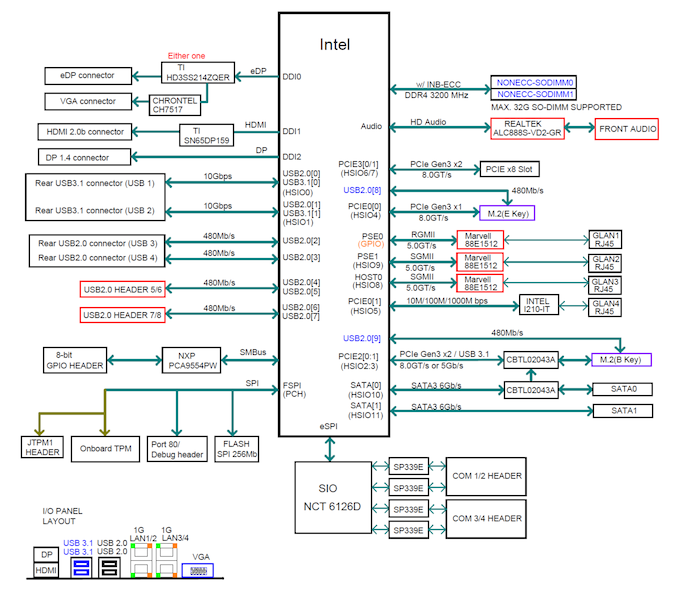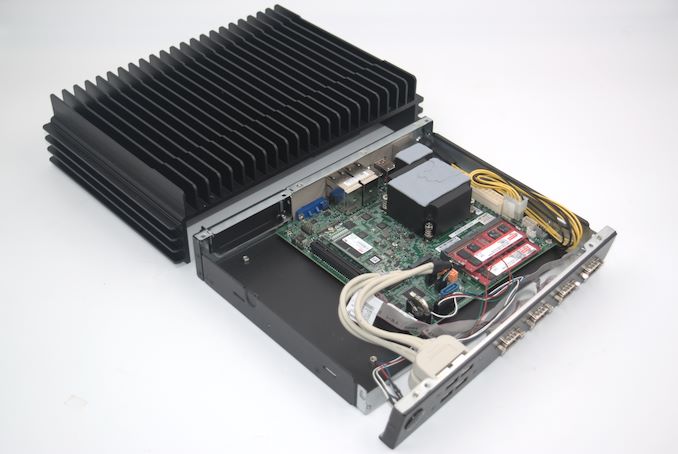Supermicro SYS-E302-12E Fanless Industrial PC Review: Elkhart Lake for IoT Applications
by Ganesh T S on March 10, 2023 8:00 AM EST- Posted in
- Systems
- Fanless
- Supermicro
- Passive Cooling
- Elkhart Lake
Setup Notes and Platform Analysis
Our review sample of the Supermicro SYS-E302-12E came with all necessary components pre-installed - we only had to load up the OS to start our evaluation process. Prior to that, we took some time to look into the BIOS interface. It must be noted that traditional out-of-band management options like a dedicated BMC LAN port or even AMT are not available for the system. The COM ports have some out-of-band management options, but that is quite limited compared to BMC / AMT. Additionally, the board's jumpers are set by default to disable TPM. So, the jumper (JPT1) must be altered to allow Windows 11 to be installed. The BIOS has plenty of other configuration options that are brought out in the video below.
The block diagram below presents the overall high-speed I/O distribution.
Since the Elkhart Lake processor is a SoC, the DMI link details between the internal PCH and the CPU are not readily available. While not much can be commented on the bandwidth allocations due to this, we do see that both USB 2.0 header pairs are brought out as Type-A ports using the thick white cables in the picture below. We also see the COM header pairs getting connected to the RS232 ports.
Access to the internal board is obtained by unscrewing the chassis from the sides and the top and pulling it up. It is necessary to do this in order to install the SODIMMs and M.2 / 2.5" drives in the case of a barebones system.
In today's review, we compare the Supermicro SYS-E302-12E and a host of other systems based on processors with TDPs ranging from 6 W to 35 W. The systems do not target the same market segments, but a few key aspects lie in common, making the comparisons relevant.
| Comparative PC Configurations | ||
| Aspect | Supermicro SYS-E302-12E | |
| CPU | Intel Atom x6425E Elkhart Lake 4C/4T, 2.0 - 3.0 GHz Intel 10, 1.5 MB L2, 12 W |
Intel Atom x6425E Elkhart Lake 4C/4T, 2.0 - 3.0 GHz Intel 10, 1.5 MB L2, 12 W |
| GPU | Intel UHD Graphics for 10th Gen Intel Processors (32EU @ 500 MHz) |
Intel UHD Graphics for 10th Gen Intel Processors (32EU @ 500 MHz) |
| RAM | Innodisk M4SI-AGS1O50K-C DDR4-2666 SODIMM 19-19-19-43 @ 2666 MHz 2x16 GB |
Innodisk M4SI-AGS1O50K-C DDR4-2666 SODIMM 19-19-19-43 @ 2666 MHz 2x16 GB |
| Storage | Innodisk M.2 (S80) 3TE7 DEM28-B56DK1EW1QF (256 GB; M.2 2280 SATA III;) (64L 3D TLC; InnoDisk ID301 Controller) |
Innodisk M.2 (S80) 3TE7 DEM28-B56DK1EW1QF (256 GB; M.2 2280 SATA III;) (64L 3D TLC; InnoDisk ID301 Controller) |
| Wi-Fi | 1x GbE RJ-45 (Intel I210-IT) 3x GbE RJ-45 (Intel EC1000S MAC + Marvell Alaska 88E1512 PHY) |
1x GbE RJ-45 (Intel I210-IT) 3x GbE RJ-45 (Intel EC1000S MAC + Marvell Alaska 88E1512 PHY) |
| Price (in USD, when built) | (Street Pricing on March 9th, 2022) US $894 (Barebones) US $1315 (as configured, no OS) |
(Street Pricing on March 9th, 2022) US $894 (Barebones) US $1315 (as configured, no OS) |
The OnLogic HX500 represents a premium fanless industrial PC with a 35W TDP processor. The Atlas Canyon NUC (based on a Jasper Lake SoC) makes an appearance as a representative of the best possible performance from the Tremont stable, while the Zotac CI331 nano makes up the low end (6W TDP SoC in a fanless configuration). The next few sections will deal with comparative benchmarks for the above systems.












16 Comments
View All Comments
t88csywi - Friday, March 10, 2023 - link
Does Intel support WSLg on these Elkhart Lake chips? Their graphics drivers have been broken for months, preventing Jasper Lake systems from running it.https://github.com/microsoft/wslg/issues/877
The_Assimilator - Friday, March 10, 2023 - link
A 150W power brick for a 12W CPU? What???danbob999 - Friday, March 10, 2023 - link
Sounds about right. People buy 500-700W PSUs for 65W CPUs, so...PeachNCream - Friday, March 10, 2023 - link
You're going to upset the people that are drooling over 1kw PSU reviews by pointing that sort of thing out to them and they'll come out of the proverbial woodwork to make claims about peak power draw, worst case scenarios, blah blah burst speeds, overclocking, and every other excuse they can make to avoid admitting they bought into the hype.mode_13h - Saturday, March 11, 2023 - link
> Sounds about right.Not for an industrial product. Also, power supplies tend to be much less efficient at such low utilization. A smaller power brick should reduce both costs and power usage.
mode_13h - Saturday, March 11, 2023 - link
Thinking about it, I can see Ganesh's point. It probably should default to a PSU capable of supporting the max power draw, and then perhaps customers requiring less could spec a leaner model or just do it aftermarket.vidal6x6 - Monday, March 13, 2023 - link
1120w for 200w system ;)Monicalia - Monday, March 27, 2023 - link
Memory has always worked this way from one generation to the next. Not in a straight line. Put aside whatever wrong ideas you may have about timing and know https://sonicexe.io that these times are excellent for 65W.mode_13h - Tuesday, March 28, 2023 - link
Spammer.ganeshts - Friday, March 10, 2023 - link
Not entirely unreasonable given the internal platform. Note that the internal board has a PCIe 3.0 x8 slot, there are two SATA ports, and two M.2 ports. Taking the 8 USB ports into consideration, I can think of the following max usage:8x USB = 40 W
2x M.2 = 20 W
2x SATA = 15 W
1x PCIe = 75 W
SoC = 12 W
DRAM = ~3-5 W
Already over the 150 W mark.. in fact, I think Supermicro also offers a 180 W power brick option for this system.